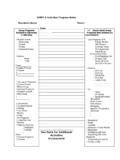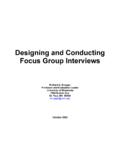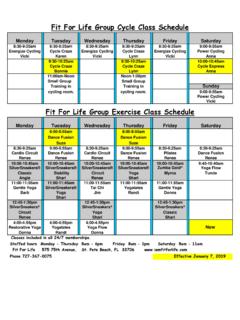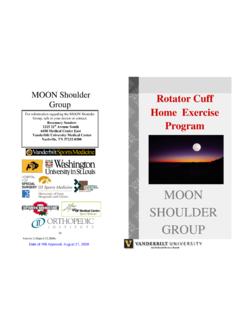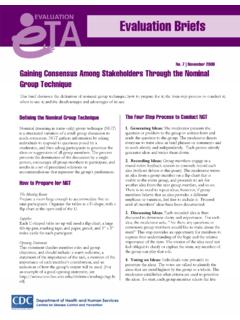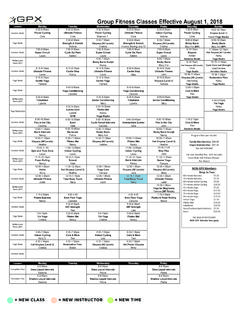Transcription of “Affinity” Focus Group exercise - Georgia Tech Library
1 affinity Focus Group exercise At Georgia Tech we sometimes use an affinity Focus Group exercise to tap into customer preferences for services, accommodations, furnishings, technology, etc., in renovated Library spaces. This can be an effective technique for sampling customer expectations and, more critically, discovering to what degree the customers expectations converge with our own. This discovery technique helps to mitigate the risk of bringing new spaces into production by helping us to align space programming with customer expectations. In past years when we conducted Focus groups, we attempted to have proportionate student participation by assembling academic majors in their relative numbers ( 13% electrical engineering, 15% computer science, 13% architecture, etc.)
2 For our most recent affinity Group exercise focused on the Library East Commons, we asked our student advisory council members to invite approximately 40 student subjects. (Several dates / times were offered; incentives may be required to assure relatively high attendance). We did try to approximate the GT ratio of undergraduate to graduate student. For this study, we invited a Group of academic faculty. We also interviewed a Group of Library and OIT staff since we collaborate in the East Commons venture. To prepare: Depending on your circumstances, imagine that you might: interview approximately 25-50 individuals (participants); invite potential participants via email; to produce the needed number of participants, send out a large number of invitations because of the high decline rate.
3 When inviting individuals to participate, simply state that the Library is considering some improvements / changes, and seeks input from campus constituents who may or may not be Library users; don t give detailed information about the project because you don t want them to do homework in advance, talk to their friends for their opinions, or create a mindset that attempts to second guess what you are looking for. schedule participants into groups of approximately 8 12 try to schedule all the sessions within a short time period .. a week or two is best indicate that the session will last one hour (any longer and participants will begin to fatigue and pull back from participation) decide whether to offer incentives to attend; we didn t, but it is frequently done have potential interview participants reply to you via email their intention to participate or not send out a last minute email reminder of date / time / location for interview set up the interview room with tables arranged in a square or circle so that participants can see each other; don t crowd participants.
4 Put no more than 2 individuals at a 6-foot table have in the room a long white board (ideal) or wall to which Post-Its easily adhere (you could substitute large flip charts for the white board, in which case you ll need approximately 10) provide 5 x 3 Post-It pads for each subject, pens, and white board markers Running the affinity Group : We provide 2 facilitators for our Focus groups (a lead and an assistant). The facilitators greet each participant as she / he arrives, offer refreshment, and ask each to take a seat at a table. As soon as most or all have arrived, introduce yourselves by indicating your role(s) in the organization, and thank the participants for attending.
5 Tell them the exercise will not extend more than an hour. Assure them that when the data / comments are compiled afterward, no one will be quoted or have a specific comment attributed to them. Describe the project they re contributing to in simple terms. For example, for the most recent GT Library project, we simply told subjects that We hope to renovate approximately 10,000 square feet on the first floor east. The space will have a small caf and a circulation service point. The remainder is up for grabs, with no preconceived notions. Or if you know that your installation will have as the centerpiece lots of computers , you could say We re doing a renovation that will have lots of PCs / Macs, but with no understanding about how this will look or feel to our students.
6 This is where you come in. Step 1 (approximately 15 20 minutes): Lead facilitator now says: You are going to help us to understand how this space might be programmed. For this first exercise , do not talk to each other, only talk to me. Each of you has a pack of Post-Its in front of you, with a pen. I want you to imagine that you are walking through the newly renovated space (or Imagine that you are able to look down onto the space from above ). What do you see? As you have ideas, as you see elements emerge, tell me what you see, and at the same time write each of your ideas on the Post-It in front of you. I want as many ideas as you can possibly muster.
7 So if you want a zebra in the space, tell me I see a zebra in this space and then write it on a fresh Post-It. If participants want assurance, or start to ask questions of the facilitator like: Will there be any high-end computers in the new space? , respond by saying: If you think high-end computers have a place in the new space, then state it, and simultaneously write it on the Post-It in front of you. You are here to tell me what you imagine .. I have no preconceived notions about the space Participants will begin to make suggestions. Make sure that each is recorded, peeled from the Post-It pack, and loosely arranged in front of each individual.
8 You frequently will have to remind participants to write down the idea they ve stated. Each participant contributes as much as she / he can. It s OK to get 3 ideas in a row from one individual. The flow of ideas is random. It s OK if someone has a contrary notion from an earlier-stated idea. All ideas are good! If participants are only offering serious ideas, you might suggest that they break free from conventional notions and go crazy. You re looking for both mundane and pie-in-the-sky brainstorming. If ideas stop flowing, suggest topics: Will there be furniture in the space? , You ve mentioned high-end computers .. what can you do on them?
9 , Will there be playful aspects to this space? , Who do you see using the space? , But avoid making specific suggestions. You don t want them to know what s on your mind, or they could attempt to please you with their suggestions. You re trying to draw out what s in their imagination. You will likely generate anywhere from 50 100 suggestions. Whatever else they do, the facilitators must be dedicated to creating an exercise that produces genuine discoveries, taps the wisdom that exists in the minds and hearts of the participants, and opens up avenues that the official planning Group or committee has not conceived of. Step 2 (approximately 10-15 minutes): Now instruct the participants to gather all their Post-It notes and take them to the white board.
10 Working silently (no discussion / chat with each other) instruct them to arrange their written suggestions into affinity groups. They re allowed to move a Post-It from one Group to another. They may move both theirs and other individuals notes. If a note appears to change groups 3 times, then the facilitator will create a duplicate of that note to appear in both emerging affinity groups. The participants often create orphans , ideas that seem to belong in no emerging Group . Encourage them to do the best they can to incorporate orphans into affinity groups. Usually these orphans get incorporated, though sometimes with tenuous relationship.
